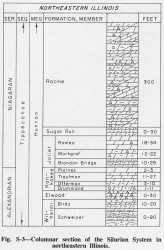Kankakee Formation
Lithostratigraphy: Hunton Limestone Megagroup >>Kankakee Formation
Chronostratigraphy: Paleozoic Erathem >>Silurian System >>Alexandrian Series
Allostratigraphy: Tippecanoe Sequence
Primary source
Willman, H. B., Elwood Atherton, T. C. Buschbach, Charles Collinson, John C. Frye, M. E. Hopkins, Jerry A. Lineback, and Jack A. Simon, 1975, Handbook of Illinois Stratigraphy: Illinois State Geological Survey Bulletin 95, 261 p.
Contributing author(s)
H. B. Willman and Elwood Atherton
Name
Original description
Kankakee Formation (Savage, 1916, p. 316).
Derivation
Named for the Kankakee River in Will County.
Other names
History/background
Type section
Type location
The type section of the Kankakee Formation is located in Cowan's Quarry and adjacent bluffs of the river 3.5 miles southeast of Ritchey (SE SW NW 26, 32N-10E), where the formation is 18 feet thick.
Type author(s)
Type status
Reference section
Reference location
Reference author(s)
Reference status
Stratigraphic relationships
The Kankakee Formation is the uppermost formation in the Alexandrian Series in northeastern, central, and western Illinois (figs. S-3, S-5).
Extent and thickness
The Kankakee Formation is commonly about 40 feet thick where exposed along the Des Plaines River Valley southwest of Joliet (Willman, 1973) and in subsurface elsewhere in northeastern Illinois. It has a similar thickness in exposures in Calhoun and Jersey Counties in western Illinois (Rubey, 1952), but in part of western Illinois it is completely truncated by Middle Devonian strata. The Kankakee Formation is traced in subsurface from the type region to exposures in Calhoun and Jersey Counties in western Illinois, where the formation is somewhat purer and the wavy bedding and green clay partings are less conspicuous.
Lithology
In the type area the Kankakee Formation consists largely of greenish to pinkish gray, fine- to medium-grained, slightly cherty, glauconitic dolomite, generally in wavy beds 2-4 inches thick that are separated by thin green clay partings. It is differentiated into four members. The Drummond Member (at the base) is the most massive, and commonly contains a few rounded quartz sand grains and the most glauconite. The overlying Offerman Member is very thin bedded, slightly argillaceous, and weathers lighter in color than the other members. The overlying Troutman Member makes up the greater part of the formation and has the typical character of the formation. It is overlain by the nearly white Plaines Member, which is massive except for a few thin clay partings near the base. The top of the Plaines is a distinctive, flat surface that is smooth except for small sharp-sided pits about half an inch deep that form a roughly evenly spaced pattern at 3-6 inch intervals. The pits are filled with bright green clay. This surface has been interpreted as an unconformity at the base of the Niagaran Series, but there is slight if any truncation of the Plaines Member, which is only 2-3 feet thick, and the surface is more likely a corrosion surface on which strata may be absent because of nondeposition rather than subaerial erosion. The formation varies from fine-grained, gray limestone in the north part of the western Illinois outcrop area to porous brown dolomite in the south part. The Kankakee is not differentiated into members in western Illinois, but the Platymerella Zone is present at the base and the Microcardinalia Zone at the top.
Core(s)
Photograph(s)
Contacts
Well log characteristics
Fossils
The Kankakee Formation is generally fossiliferous, and corals, particularly Halysites and Favosites (fig. S-12), are common to abundant throughout the formation (Savage, 1926). Although the basal Drummond Member contains the Platymerella Zone, these fossils are also locally common in the upper few feet of the underlying Elwood Formation. The Plaines Member at the top of the formation contains the Microcardinalia Zone where that fossil, along with Pentamerus oblongus (fig. S-12), occurs in dense clusters, most commonly in the lower part of the member and occasionally as scattered individuals in the Troutman Member below.
Age and correlation
Although fossils indicate the equivalence of the Kankakee to the Sexton Creek Limestone in southern Illinois, the type Sexton Creek does not closely resemble the Kankakee. It lacks both the upper and lower faunal zones, and may be equivalent to only part of the Kankakee. The Kankakee Formation is essentially equivalent to the Brassfield of Indiana, Kentucky, and Ohio, but the Brassfield locally includes strata equivalent to the Wilhelmi and Edgewood in Illinois. The Kankakee is equivalent to the Mayville, Byron, and Hendricks Formations in eastern Wisconsin. However, the Mayville and Byron locally include strata equivalent to the Wilhelmi and Elwood Formations. The Kankakee is lithologically similar to the Sweeney Formation in northwestern Illinois.
Environments of deposition
Economic importance
Remarks
References
RUBEY, W. W., 1952, Geology and mineral resources of the Hardin and Brussels Quadrangles: USGS Professional Paper 218, 179 p.
SAVAGE, T. E., 1916, Alexandrian rocks of northeastern Illinois and eastern Wisconsin: Geological Society of America Bulletin, v. 27, p. 305-324.
SAVAGE, T. E., 1926, Silurian rocks of Illinois: Geological Society of America Bulletin, v. 37, p. 513-533.
WILLMAN, H. B., 1973, Rock stratigraphy of the Silurian System in northeastern and northwestern Illinois: Illinois State Geological Survey Circular 479, 55 p.
ISGS Codes
| Stratigraphic Code | Geo Unit Designation |
|---|---|


